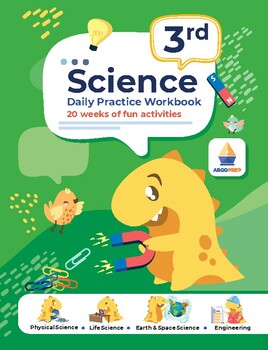3rd Grade Science Workbook (170 pages eBook + video explanations)
- PDF
Description
3rd Grade Science Daily Practice workbook by ArgoPrep is designed to help build mastery of foundational science skills. Our science workbooks offer students with 20 weeks of practice of various science skills required for third grade including Physical Science, Life Science, Earth & Space Science, and Engineering.
Students will explore science topics in depth with ArgoPrep’s 5 E’S to build science mastery.
- Engaging with the topic: Read a short text on the topic and answer multiple choice questions.
- Exploring the topic: Interact with the topic on a deeper level by collecting, analyzing and interpreting data.
- Explaining the topic: Make sense of the topic by explaining and beginning to draw conclusions about the data.
- Experimenting with the topic: Investigate the topic through hands on, easy to implement experiments.
- Elaborating on the topic: Reflect on the topic and use all information learned to draw conclusions and evaluate results.
ArgoPrep’s 3rd Grade Science Daily Practice Workbook is state-aligned and aligns with the Next Generation Science Standards (NGSS). This workbook also includes detailed video explanations, which you can access on our website for free after purchase. *(All ArgoPrep workbooks come with detailed video explanations where we go over every question to help all types of learners!)
Here’s a preview of what our workbook covers!
- Balanced and Unbalanced Forces
- Predicting Future Motion
- Electric Interactions
- Magnetic Interactions
- Problem Solving with Magnets
- Life Cycles
- Animal Groups
- Environmental Influence on Traits
- Habitats and Survival
- Environmental Changes
- Seasons and Weather - Part 1
- Seasons and Weather - Part 2
- Weather vs. Climate
- Regional Climates of the United States
- Weather-Related Hazards
- Identifying a Problem
- Developing Solutions
- Designing Solutions
- Building & Testing Solutions
- Evaluating Solutions
ArgoPrep is one of the leading providers of supplemental educational products and has been awarded 15+ educational awards in just the past year. ArgoPrep is used by over 1 million students nationwide.
For any issues or concerns, email us at info@argoprep.com





